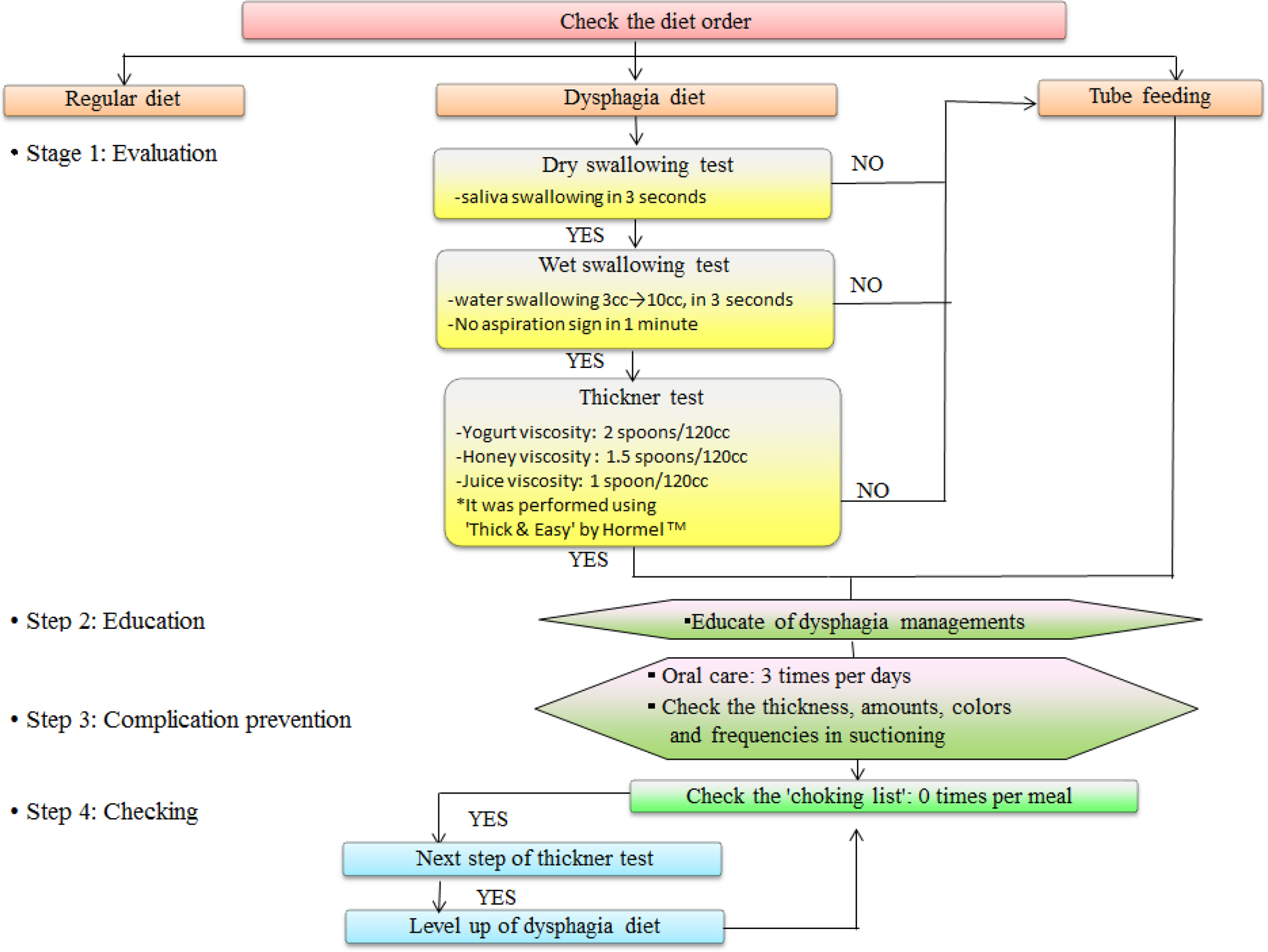Asan Medical Center, Seoul, Korea
Copyright © 2015 Korean Society of Adult Nursing
This is an Open Access article distributed under the terms of the Creative Commons Attribution Non-Commercial License (http://creativecommons.org/licenses/by-nc/3.0) which permits unrestricted non-commercial use, distribution, and reproduction in any medium, provided the original work is properly cited.
| Variables | Categories | Cont. (n=80) | Exp. (n=64) | x2 or t | p | Predictors | Adjusted OR (95% CI) | p |
|---|---|---|---|---|---|---|---|---|
| n (%) or | n (%) or | |||||||
| M±SD | M±SD | |||||||
| Incidence of aspiration pneumonia† | 13 (16.3) | 3 (4.7) | 4.81 | .028 | DNP | 0.26 (0.67~0.97) | .045 | |
| Discharged MRS | 0 | 5 (6.3) | 16 (25.0) | 19.32 | .002 | |||
| 1 | 12 (15.0) | 14 (2.9) | ||||||
| 2 | 10 (12.5) | 6 (9.4) | ||||||
| 3 | 18 (22.5) | 7 (10.9) | ||||||
| 4 | 21 (26.3) | 19 (29.7) | ||||||
| 5 | 14 (18.0) | 2 (3.1) | ||||||
| Dependency ratio (=MRS 3~5)‡ | 53 (66.3) | 28 (43.8) | 7.31 | .011 | DNP | 0.33 (0.14~0.78) | .011 | |
| Initial NIHSS | 1.18 (1.05~1.32) | .007 | ||||||


Research Design of the Study
| Groups | Pretest | Treatment | Posttest |
|---|---|---|---|
| Exp. | X | O2 | |
| Cont. | O2 |
Exp.=experimental group; Cont.=control group; X=dysphagia nursing protocol; O2=Baseline characteristics, incidence of aspiration pneumonia, discharged modified ranken scale, dependency ratio.
The Demographic and Disease-related Characteristics at Baseline (N=144)
| Characteristics | Categories | Cont. (n=80) | Exp. (n=64) | x2 or t | p |
|---|---|---|---|---|---|
| n (%) or M±SD | n (%) or M±SD | ||||
| Age (year) | 69.26±12.44 | 65.92±16.21 | 1.40 | .163 | |
| Gender | Male | 45 (56.3) | 34 (53.2) | 0.62 | .575 |
| Smoking | Never smoker | 55 (69.0) | 43 (67.0) | 0.42 | .811 |
| Ex-smoker | 8 (10.0) | 5 (8.0) | |||
| Smoker | 17 (21.0) | 16 (25.0) | |||
| Initial NIHSS | 7.78±5.32 | 6.75±4.53 | 1.26 | .136 | |
| Initial MRS | 0 | 0 (0.0) | 1 (1.6) | 4.61 | .465 |
| 1 | 4 (5.0) | 7 (10.9) | |||
| 2 | 12 (15.0) | 7 (10.9) | |||
| 3 | 14 (17.5) | 15 (23.4) | |||
| 4 | 37 (46.3) | 24 (37.5) | |||
| 5 | 13 (16.3) | 10 (15.6) | |||
| TOAST | LAD | 29 (36.3) | 14 (21.9) | 5.49 | .240 |
| SVD | 9 (11.3) | 13 (20.3) | |||
| CE | 21 (26.3) | 15 (23.4) | |||
| Undertermined | 9 (11.3) | 11 (17.2) | |||
| Others | 12 (15.0) | 11 (17.2) | |||
| Days of keeping dysphagia diet/tube feeding | 10.14±6.80 | 8.77±5.10 | 1.34 | .271 | |
| Discharge status | Home | 28 (34.9) | 21 (32.8) | 2.33 | .675 |
| Rehabilitation unit | 33 (41.3) | 24 (37.5) | |||
| Other hospitals | 19 (23.8) | 19 (29.7) | |||
| Length of stay | 10.75±6.70 | 8.97±5.15 | 2.33 | .278 | |
NIHSS=national institutes of health stroke scale; MRS=modified ranken scale; TOAST=trials of org 10172 in acute stroke; LAD=large artery disease; SVD=small vessel disease; CE=cardiac embolism.
Outcome Analysis (N=144)
| Variables | Categories | Cont. (n=80) | Exp. (n=64) | x2 or t | p | Predictors | Adjusted OR (95% CI) | p |
|---|---|---|---|---|---|---|---|---|
| n (%) or | n (%) or | |||||||
| M±SD | M±SD | |||||||
| Incidence of aspiration pneumonia |
13 (16.3) | 3 (4.7) | 4.81 | .028 | DNP | 0.26 (0.67~0.97) | .045 | |
| Discharged MRS | 0 | 5 (6.3) | 16 (25.0) | 19.32 | .002 | |||
| 1 | 12 (15.0) | 14 (2.9) | ||||||
| 2 | 10 (12.5) | 6 (9.4) | ||||||
| 3 | 18 (22.5) | 7 (10.9) | ||||||
| 4 | 21 (26.3) | 19 (29.7) | ||||||
| 5 | 14 (18.0) | 2 (3.1) | ||||||
| Dependency ratio (=MRS 3~5) |
53 (66.3) | 28 (43.8) | 7.31 | .011 | DNP | 0.33 (0.14~0.78) | .011 | |
| Initial NIHSS | 1.18 (1.05~1.32) | .007 | ||||||
OR=odds ratio; CI=confidence interval; MRS=modified ranken scale; NIHSS=national institutes of health stroke scale; DNP=dysphagia nursing protocol;
†Adjusted by age, gender, smoking, initial NIHSS, initial MRS, TOAST;
‡Adjusted by age, gender, smoking, initial MRS, TOAST.
Exp.=experimental group; Cont.=control group; X=dysphagia nursing protocol; O2=Baseline characteristics, incidence of aspiration pneumonia, discharged modified ranken scale, dependency ratio.
NIHSS=national institutes of health stroke scale; MRS=modified ranken scale; TOAST=trials of org 10172 in acute stroke; LAD=large artery disease; SVD=small vessel disease; CE=cardiac embolism.
OR=odds ratio; CI=confidence interval; MRS=modified ranken scale; NIHSS=national institutes of health stroke scale; DNP=dysphagia nursing protocol; Adjusted by age, gender, smoking, initial NIHSS, initial MRS, TOAST; Adjusted by age, gender, smoking, initial MRS, TOAST.

